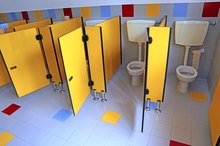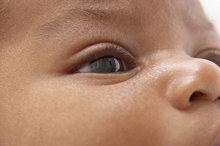Normal Bladder Capacity in Children
Diapers, potty training and bed-wetting are all common scenes in a child's life. The capacity of your child's bladder changes and increases over time as he grows and develops. It is important to know normal bladder capacity in children so that you can gauge and detect urinary problems that your child may have. Most of these problems go away as your child ages, but some lifestyle variables can help improve your child's irregular urination patterns.
If you are experiencing serious medical symptoms, seek emergency treatment immediately.
Calculating Bladder Capacity
A 1997 study published in the “Journal of Urology” tested over 2,000 children at the Children's Hospital and Harvard Medical School. Those tested had no clinical abnormalities in bladder function. The findings of the researchers included two accurate formulas for calculating the bladder capacity in ounces for children, depending on age. For children under 2 years of age, multiply 2 times the child's age in years, and add 2. For children over age 2, take the child's age in years divided by 2 and then add 6.
- A 1997 study published in the “Journal of Urology” tested over 2,000 children at the Children's Hospital and Harvard Medical School.
- The findings of the researchers included two accurate formulas for calculating the bladder capacity in ounces for children, depending on age.
Significance
Normal Urinary Frequency per Day for Children
Learn More
The children's study performed at Children's Hospital and Harvard Medical School reveals that on average, the capacity that a child's bladder can hold is near to the same as her peers of the same age. As your child grows and develops, her bladder will also maintain a consistent growth pattern, and this formula can be used each year as your child ages to determine the new bladder capacity of your child.
Functions of the Bladder
The bladder is a musculomembranous sac that is used to store urine before being eliminated from the body. The bladder is located below the kidneys and is connected to the kidneys by tubes known as ureters. The size of the bladder varies depending on age and gender.
Bladder Disorders in Children
Child Symptoms of Urethritis
Learn More
A number of conditions exist that may affect your child's urination habits. An overactive bladder may cause your child to need to urinate every five to 10 minutes or 10 to 30 times a day. Some conditions for an overactive bladder may include having uncontrollable spasms in the bladder muscles, nighttime bed-wetting, urinary tract infections due to inflammation and infection in the urinary tract causing discomfort or pollakiuria, a condition related to stress that usually goes away after two to three weeks.
Changes in Bladder Activity
According to the National Institute of Diabetes and Digestive and Kidney Diseases, most urinary incontinence problems in children fade away naturally. Changes in the body improve a child's overactive bladder tendencies including increase in bladder size over time, the regulating of the production of necessary hormones, the ability to recognize and follow the body's signal to urinate and the passing of stressful events. Dietary modification, medication and strength training for bladder muscles may be examples of treatments that can improve a child's urination patterns.
- According to the National Institute of Diabetes and Digestive and Kidney Diseases, most urinary incontinence problems in children fade away naturally.
- Dietary modification, medication and strength training for bladder muscles may be examples of treatments that can improve a child's urination patterns.
Related Articles
References
- IvyRose Holistic: Anatomy of the Bladder and Urethra
- "Journal of Urology"; Estimating Normal Bladder Capacity in Children; M. Kaefer, D. Zurakowski, S. B. Bauer, A. B. Retik, C. A. Peters, A. Atala, S. T. Treves; December 1997
- Glazener, CM et al. "Simple behavioural and physical interventions for nocturnal enuresis in children." Cochrane Database Syst Rev. 2004.
- Jalkut, MW et al. "Enuresis." Pediatr Clin North Am. 2001;48(6):1461.
- Koff, SA. "Estimating bladder capacity in children." Urology. 1982;21(3):248.
Writer Bio
Alexis Jenkins writes to motivate others in areas of health including nutrition, fitness training and improving lifestyle choices. She graduated with a Bachelor of Science in health science from Brigham Young University-Idaho.









